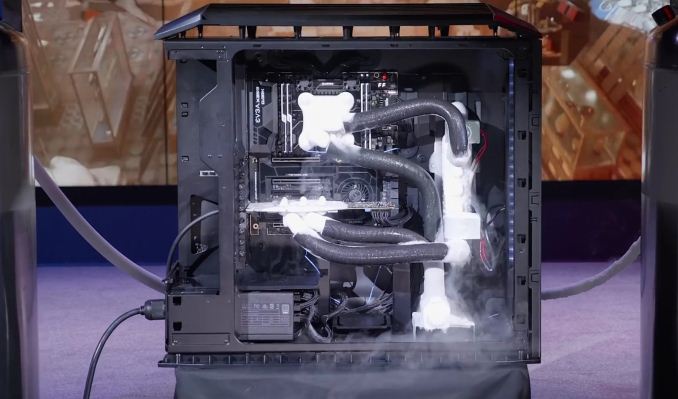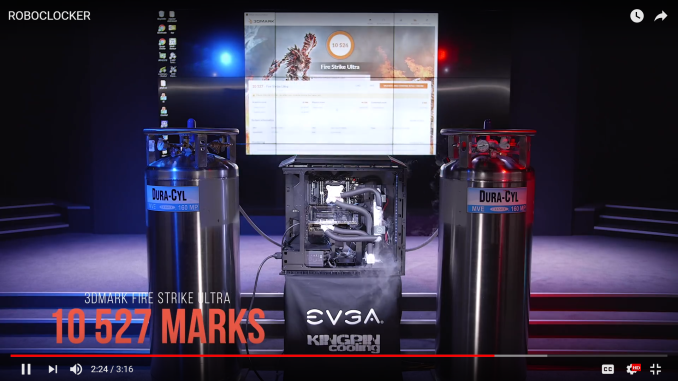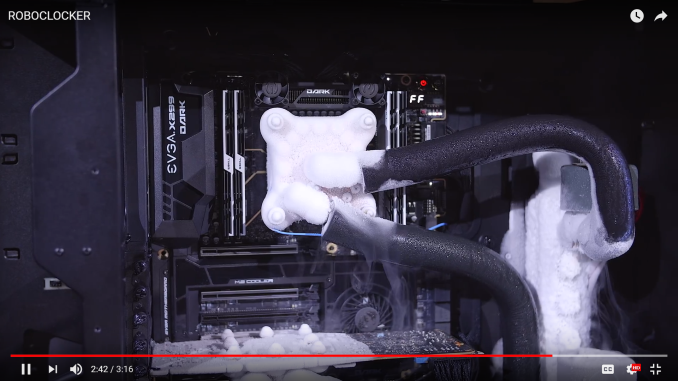EVGA Roboclocker: A Water Cooling Loop for LIQUID NITROGEN
by Ian Cutress on June 5, 2018 11:00 AM EST
One of the more esoteric elements of the technology industry are the extreme overclockers. Much like what drag racing is for cars, extreme overclocking is to computers: trying anything and everything to do the quickest benchmark. This means modifying the components, having a super streamlined OS, and to a certain extent be a money-no-object scenario.
One of the things that overclocking does is generate heat, and that needs to be kept under control. Beyond air cooling and water cooling is sub-zero cooling, using items such as dry ice to cool processors for the 20 minutes needed for that special benchmark record. Liquid nitrogen is the favored tool of extreme overclockers, being easy enough to handle and ‘reasonably’ cheap, with the lucky few having played with liquid helium.
Normally Liquid Nitrogen, as it sublimes from a liquid to a gas, requires an exit: the ability to escape by using an open pot is key to how to get a system to overclock beyond 6 GHz. EVGA has gone crazy, by developing a closed water-loop esque system for liquid nitrogen. I cannot explain how insane this is.
As shown in the image above, using these coolants invokes moisture, and water is bad for the system. Liquid nitrogen overclocking requires motherboard preparation, in this case, to stop moisture from affecting the components. What exactly EVGA is doing here to stop moisture I have no idea. The tool they have in place is called ROBOCLOCKER.
| Want to keep up to date with all of our Computex 2018 Coverage? | ||||||
 Laptops |
 Hardware |
 Chips |
||||
| Follow AnandTech's breaking news here! | ||||||















13 Comments
View All Comments
rocky12345 - Tuesday, June 5, 2018 - link
Yep pretty crazy but also very very cool. This is one small step towards maybe some day having this as a option to become a common thing in every day system's. That is once they learn how to turn the LN2 back into liquid form and make it a closed loop type system. Probably not an option I am sure there would be big hurtles involved to get it so it could become a closed loop system without the need of the huge LN2 containers. I am also thinking they would have to be able to make it so it would not cool the system down to extreme sub zero temps as well so an every day system would not die from moisture getting every where.Ok so probably won't see this in an everyday system but man it is cool that they can make it so even a new to the scene extreme over clocker could do this without to much hassle.
SodaAnt - Tuesday, June 5, 2018 - link
We won't ever have something like that because of the laws of physics. Water cooling works because the system can just dump the excess heat through the radiator because the water temp is higher than ambient temp. To keep a system like this working without a large reserve of liquid nitrogen (which would run out anyways), you'd need something to actively cool the LN2 back to below the evaporation point, and that would take an order of magnitude more energy than the computer does.DanNeely - Tuesday, June 5, 2018 - link
It's an openloop setup, with the LN2 being sent from one external tank to the next (minus the ~25% that boils off and is vented). The tanks are visible if you've got a bigger zoom than in the video Ian screenshotted.https://www.youtube.com/watch?v=kgnfvb2t-TQ
edzieba - Tuesday, June 5, 2018 - link
Re-compressing the cold gaseous N2 to LN2 is trivial (it's how LN2 is made in the first place, as a byproduct of chilling air to produce LOX), the problem is doing so with equipment that is not out of the pricerange of even this bonkers system. LN2 is so cheap that it would probably work out more cost effective just to buy LN2 and run open loop than to try and recover it.rahvin - Tuesday, June 5, 2018 - link
Even with LN2 a little bit cheaper than milk you'd be burning through so much of it that it would cost a pretty penny, not to mention the rental costs for some super chilled vaccum flasks and the hazards of storage.You'd also be purchasing so much LN that you'd probably set off all kinds of alarm bells and trigger a police investigation. Keep in mind nitrogen is a severe suffocation hazard just like CO and you don't even know you are suffocating because there is no pain. So your local city isn't going to be very keen on you storing any significant quantity of this stuff in a residence.
In other words is a neat little experiment but don't plan on running one of these full time unless you have a lot of money you want to burn and have a good lawyer for when the cops come calling about all the gas you are buying.
Santoval - Tuesday, June 5, 2018 - link
A (commercial) system like that would be unfeasible due to the extreme energy required to recool nitrogen below its boiling point. Perhaps it could be done with a compound or element with a higher boiling point than nitrogen but still much lower than that of water. That way you would sacrifice a part of nitrogen's cooling capacity for a large gain in energy. Nitrogen boils at -196 °C, so some ideas might be R22 refrigerant (-41 °C) and CO2 (-78 °C but a pressure of 5+ atmospheres would need to be applied, below that it sublimates), along with some other largely dangerous, toxic and/or very flammable ideas like propane, hydrogen sulfide or... hydrochloric acid.The best solution would probably be CO2, since it is inert and non toxic, with a reasonably low boiling point but not low enough to require wasting excessive energy to cool it. But the cooling system would need to have a constant internal pressure above 5 atm (73+ psi) for it to remain liquid. That means much better and tighter sealing, thicker tubes and an additional pressure inducing and regulating mechanism. I believe it is feasible since the required pressure is not very high, but it would be quite expensive.
An R22 based cooling system would be much easier and cheaper obviously, but it would provide quite less cooling power than CO2. It also has the not so slight problem of being an ozone depleting CFC compound.
gfra11 - Tuesday, June 5, 2018 - link
Something does not "sublime" from liquid to gas, it evaporates ;)boozed - Thursday, June 7, 2018 - link
That line in the article made me laugh.PeachNCream - Tuesday, June 5, 2018 - link
No thanks EVGA-Elsa, I don't want to build a snowman. All that frozen condensation looks like a hardware failure that's only minutes away from happening because someone found a way to turn the stupid dial up to 11.DanNeely - Tuesday, June 5, 2018 - link
If you're doing it right, all the electronic surfaces on your sub-ambient setup are coated in waterproofing to prevent that sort of disaster. If you missed any spots the magic smoke will let you know soon enough.